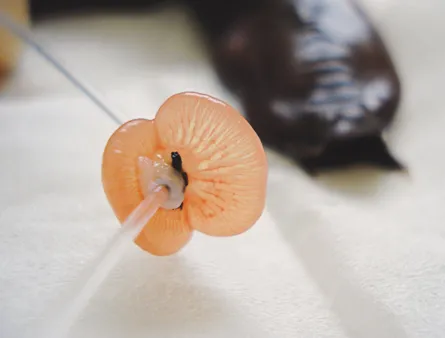When Pacific hagfish burrow into a carcass and eat their way out, they may be feeding directly through their gills and skin as well as their guts.


Lab tests suggest that hagfish actively take up nutrients through their outer tissues, says fish physiologist Chris M. Wood of McMaster University in Hamilton, Canada. Plenty of marine animals without backbones can feed through their skin, but no one had demonstrated the power in a species so close to fish and modern vertebrates, Wood and his colleagues say in a paper to be published in the Proceedings of the Royal Society B.
“One of the important steps in evolution was abandoning feeding through the skin and concentrating on feeding through the gut,” Wood says. Skin with strong barriers against outside substances allowed animals to keep their inner chemistry more separate from the outside world, and thus move into fresh water or onto land.
Hagfishes may not quite count as true modern vertebrates, because their bony skulls don’t lead to bony vertebrae making up a backbone. Instead what’s called a notochord, a flexible rod of tissue, extends along hagfish backs. Wood calls hagfishes “ancient vertebrates” in honor of their status, currently under debate, as descendants of close relatives to the first fully backboned vertebrates.
To test the idea that these almost-vertebrates use skin-feeding powers during full-contact dining, Wood and his colleagues removed bits of skin or gills from the fish but provided glucose to the tissues to keep cells functioning for at least several hours. Then researchers exposed the outside of the tissues to varying solutions of two amino acids and checked the other side of the tissue to see how much of the nutrients passed through, and under what circumstances.
If nutrients were just passing through as if the tissue were a lifeless sheet, then increasing the concentrations of nutrients on one side would have increased the concentrations on the other side. Yet that’s not what happened, the researchers found. Rising concentrations reached a plateau on the “inner” side of the hagfish tissue. That’s a characteristic sign the tissues are actively taking up a substance, in which case the transport mechanism can get saturated, Wood explains.
Also, taking sodium away from a seawater-like soup of nutrients on the outside of the tissue disrupted passage through the gills. That blockage, Wood says, suggests the hagfish tissue is using a transport system familiar from other organisms, in which sodium is among the molecules required for amino acids to be ferried through a tissue.
Another longtime hagfish biologist, Frederic Martini of the University of Hawaii at Manoa, welcomes the attention to the physiology of hagfishes, but says he’d like to see what hagfish would do with other kinds of nutrients besides amino acids.
Also, “what you can show in a lab isn’t always functionally relevant,” he cautions. In the real world the hagfish may not be doing so much carrion-burrowing, he says, because some populations seem so big he suspects the animals prey on animals still living.
Wood says he’s trying to study more natural feeding behavior. In lab tanks, though, hagfish turn out to be uncooperative, picky eaters.






